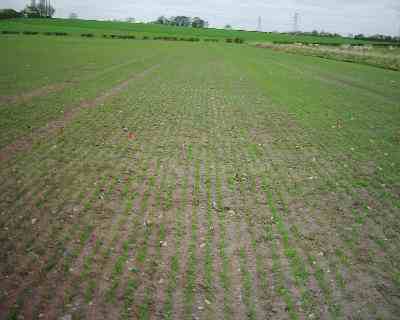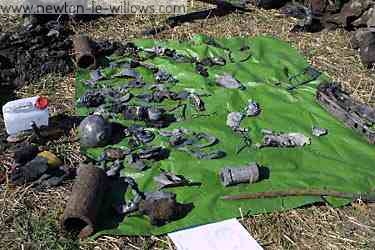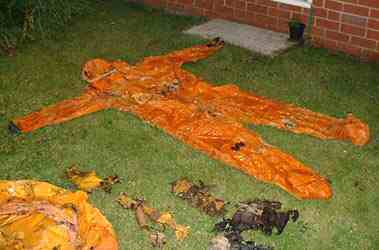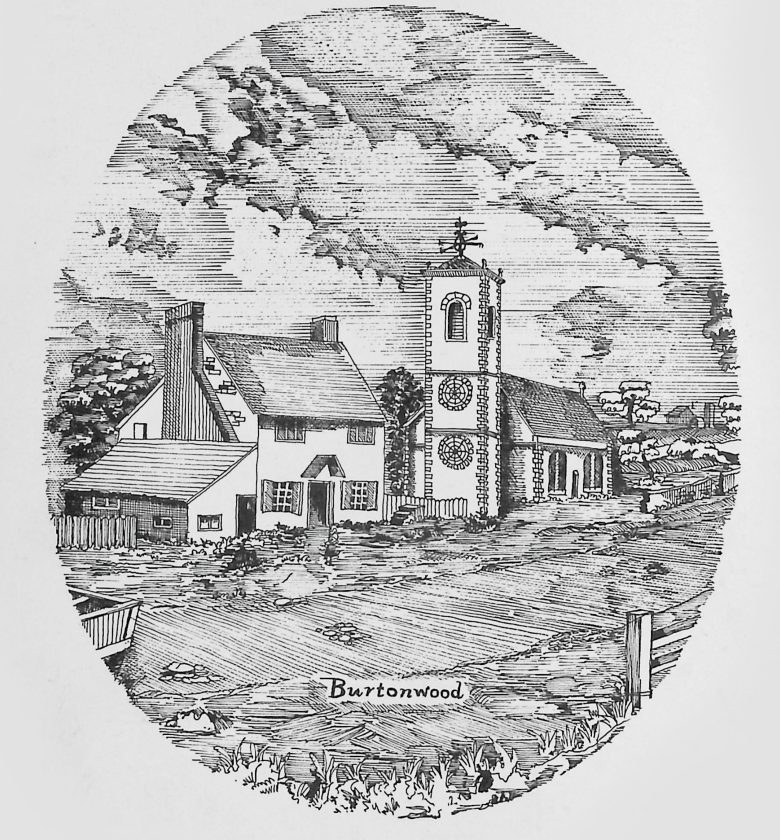| Supermarine Attacker FB.1 WA535 – 05/02/1953 |
|
On Thursday 5 th February 1953 Mr Roy Edwin Collingwood (all commissioned Pilots were known as Mr) took off from Royal Naval Air Station Stretton ? ?HMS Blackcap? near Warrington in Supermarine Attacker FB.1, No WA535 on what was to be his 3 rd ?Famil? (Familiarisation) flight at 15:30 hours. At 15:32 hours he was given ?Go? on Channel Baker, and at 15:37 hours he was called up by Mr Lines, who was then flying a Meteor aircraft. In the course of a short conversation Mr Collingwood said he was flying at 17,000 feet and was climbing, presumably to the required height in order to carry out a high speed run which he was required to perform during his 3 rd familiarisation run.
|
|
Mr Roy Edwin Collingwood in the cockpit of a Sea Fury during the Korean War
Supermarine Attacker FB.1 WA535 at Supermarines airfield at South Marston, Wiltshire, in August 1952
|
| Nothing further was heard of Mr Collingwood, but at 15:58 hours news was received from Manchester Zone Control at Ringway aerodrome that an unidentified aircraft had crashed near Burtonwood. Every effort was made to call up Mr Collingwood on all frequencies, an aircraft being diverted from ADDLS (Assisted Dummy Deck Landings) to call Mr Collingwood on Channel Baker.
|
| In the meanwhile, air traffic control at Stretton contacted Burtonwood by telephone and were informed that a jet aircraft of unknown type was seen to crash in a position three miles East of Burtonwood into a field on Lower Alder Root Farm and that the USAF had sent out their crash services. The aircraft had apparently crashed at 15:50 hours. The aircraft which had been withdrawn from ADDLS was vectored to a position East of Burtonwood to search for the crashed aircraft, and at 16:16 hours the pilot reported over the scene of the crash but was unable to identify the crashed aircraft. The Stretton crash services left for the scene at 16:30 hours.
|
| Included in the Stretton crash services were the Duty Air Traffic Controller and the Inspection Officer. At the scene of the accident they found nearly all early action had been taken by the USAF personnel, who had extinguished the fire and had posted guards. The police were also on the scene and arrangements were made for them to collect eyewitness statements.
|
| The aircraft had apparently entered soft and sodden ground in an approximately vertical attitude, there was no evidence of an oblique entry. The aircraft which had made a crater 10 feet in diameter and the main planes, which had sheared off and reduced to small fragments, had left a linear depression, debris had been spread over a wide area to a distance of 100 yards from the centre of the crater, and for most part in a Easterly direction. The parts of the aircraft which remained on the surface had been reduced to small and crumpled and unidentifiable pieces of metal, with the exception of a few larger components such as the main oleos. One portion of wreckage was recovered which bore the aircraft number, WA535. According to the Naval Board of Inquiry the aircraft was embedded in soft sodden soil to a depth of 20-25 feet, the jet pipe was uncovered by digging to a depth of 6 feet using two pumps continuously as the hole rapidly refilled with water as soon as pumping was suspended. The recovery of the wreckage was abandoned as the Investigation board thought the operation to be to costly after consulting with a civil engineer who found it difficult to produce a firm estimate and also nothing of value would be obtained by the salvage of the wreckage. Arrangements were then made with the farmer for the erection of a wire fence around the crater and for periodical visits to be made by Naval personnel to the site to ensure no unauthorised excavation had taken place. This fence stood for many years until the crater was filled in and all traces of the crash removed. All the debris of the crash, which remained on the surface was taken to Stretton.
|
|
Crash site of WA535 in April 2003 marked by pegs |
| The incident was observed by a number of individuals as follows,
Captain Van Horn USAF was on the tarmac at Burtonwood when he saw an aircraft approach from a distance of 3 to 4 miles from the west, and kept it in view until he saw it enter the ground at a point to the northeast. When he first saw the aircraft it was approaching slightly from the northwest at about 3,000 feet, gradually loosing height and increasing in speed. His impression was that the aircraft was under control. As the aircraft reached the centre of the airfield it went into a climb and proceeded in a vertical climb to a height of 8,000 to 9,000 feet. At the top of the climb the aircraft ?winged? over left and went into a vertical dive. Captain Van Horn was still under the impression that the aircraft was under control and expected it to pull out of the dive. It was only when he realized the aircraft was diving to earth without, as far as he could see, any apparent effort to pull out, that he realized there was something wrong. Peter Haselden who was cutting hedges near to Burtonwood at the time recently recalled the events, ? I was cutting some hedges near Burtonwood when I saw the smoke in the distance and the Burtonwood crash trucks leaving the base. After work I stopped of at the crash site just as a Naval nurse was walking across the field towards an ambulance, I was then given a small piece of aluminium from the wreckage by the farmer I worked for and I still have that piece to this very day?. Maurice Hammack who was on the small arms firing range at Burtonwood recently recalled how he witnessed the Attacker break out of the clouds and dive vertically into the ground, he then immediately rode across to the crash site on his motorbike with a colleague a few local farmers had also just arrive at the scene, Maurice assisted in securing the site until the crash crews arrived, he recalled how the wings had left a distinct groove in the ground either side of the crater. Tony Forester who was at Stretton during 1952-53 recently recalled that whilst he was on crash duty they were called out to attend a crash they were taken by coach in the dark to the crash site were they had to post a guard over the site taking shelter from the rain in the barn, he commented that the field was very boggy and that the crater was flooded he also recalled that he later heard the canopy was found towards the Rainhill direction.
|
| The original Board of Inquiry could not determine the actual cause of the accident, but the possible cause of the accident was put down to the following,
· The Briefing – Even though there was evidence to suggest that Mr Collingwood had gleaned considerable information regarding the Attacker aircraft and its flight characteristics, the Board of Inquiry was not satisfied that proper instruction had been given. The familiarisation of Mr Collingwood appeared to have been carried out in a casual manner, indetermate conversations replacing proper instruction. The board was of the opinion that the 3 rd familiarisation flight in an Attacker requires much more careful briefing, particular on the peculiar characteristics of the Attacker to nose down when reaching the compressibility range. This tendency is quite different from the behaviour of the jet aircraft Mr Collingwood would have met on his conversion course. This could have explained the behaviour of the aircraft when witnessed by Captain Van Horn, as a pilot who was unaware of an Attacker to nose down when approaching compressibility would adjust his elevator trim to nose up in order to counteract this tendency, as the aircraft left the zones of compressibility the aircraft would have considerable nose up trim causing the aircraft to go into a vertical climb at the top of which the pilot losses control and dives to earth. · Anoxia ? The Board of Inquiry were satisfied that Mr Collingwood was conversant with and was using the oxygen system and that sufficient Oxygen was in the tanks. The possibility that Mr Collingwood was suffering from Anoxia could not have been ruled out as it was not possible to obtain any test results, the oxygen equipment was also considered to have been to badly damaged to render any useful evidence. This could have explained the behaviour of the aircraft when witnessed by Captain Van Horn, can be explained by the theory that, having descended into the lower layers the pilot was recovering from the effects of Anoxia realising suddenly that he was near the ground pulled into a steep climb, but at the end of this climb was not sufficiently in possession of his senses to recover from the ensuing stall and dive. · Aerobatics ? From the evidence of the eyewitnesses that the aircraft appeared to be under control the Board of Inquiry discounted the possibility of aerobatics being the cause of the accident because of the unanimous evidence testifying to the steadiness of Mr Collingwood as a pilot, which is accepted that he would have been most unlikely to carry out any unauthorised aerobatics in a type of aircraft with which he was unfamiliar. However the steadiest pilots have been known to carry out unauthorised aerobatics in the past and the possibility of this being the cause of the accident, although not supported by the Board of Inquiry was a possibility. · Jamming of Controls ? There was no evidence to suggest that the aircraft was carrying out aerobatics or inverted flight which could have dislodged any loose article, the evidence of the rigger of the aircraft who examined the cockpit for loose articles and of the previous pilot who had flown the aircraft prior to Mr Collingwood did not support this possibility. However further evidence was obtained by the discovery of a further witness and the discovery of the canopy remains and the pilots helmet a few days after the crash. A Mr Hambling had been waiting to catch a bus in Leech Lane when he saw the Attacker cross the road in a very fast inverted shallow dive and then saw an object fall away from the Attacker as it climbed steeply into the clouds , the object then crashed into the street and a thud was also heard behind some nearby houses, the jettison and canopy rails along with the pilots helmet were found on near by farm land about 2 miles from the crash site, the remains of the canopy were also later found in a dismantled state on a nearby farm already the perspex had started to be used as domestic fire lighters. The Board of Inquiry later reconvened and ruled the Anoxia was considered to be the most likely cause of the accident to as it was known that a pilot suffering from this may carry out the most unusual manoeuvres without being aware of the fact. When taking into consideration the time factor of approximately 20 minutes that the pilot was airborne this also married up with previously suspected cases of anoxia in Attacker aircraft. The evolutions performed by the aircraft were also consistent with an aeroplane flying itself with very little assistance from the pilot. The jettisoning of the canopy and a possible attempt at ejection at the moment of impact also pointed to a certain amount of returning lucidity to the pilot. The board also presumed that the pilot became Anoxic in the climbing attitude with nose up trim on the aircraft and that the aircraft then stalled and went into a dive from which, with increasing airspeed, it recovered and went into a climb due to the trim. From this climb the aircraft again stalled and repeated the manoeuvre, gradually loosing height. It would appear the pilots helmet had been unfastened and when the canopy left the aircraft the buffeting in the cockpit was sufficient to lift the helmet of the pilots head and out of the cockpit.
|
|
Mr Roy Collingwood (front right) at RNAS Lee-on-Solent as a Probationary Pilot with No 15 Rating Pilots Course in July/August 1948
Mr Roy Collingwood (back right) at Lossiemouth with OFS 1 (Seafire) 1950 |
| Roy Edwin Collingwood was an only child born in Thorpe Bay, Essex around 1930, he joined the Navy at RNAS Lee-on-Solent as a Probationary Pilot with No 15 Ratings Pilot Course in July/August 1948. The initial entry of around 80 was reduced to 20 after aptitude test and medical examinations. Roy then trained at RAF Syerston on Harvards gaining his flying wings/badge on the 5 th April 1950 only 6 of the original 20 qualifying, becoming a Pilot 4 th Class being paid 7/6d a day. Roy then preceded to OFS1 at Lossimouth to convert to the Seafire followed by OFS2 at Culdrose were he converted to the Sea Fury. After converting to the Sea Furry Roy was sent to Korea and took part in many operational flights undertaking ground attack sorties in the Sea Fury with No 807 Squadron after returning from Korea he joined No 767 squadron in October 1952 and went on a short jet conversion course at Culdrose in December 1952.
Although he had only been with the squadron since October 1952 and had not qualified as a ?Mouse? (Deck landing qualified), he had become an extremely popular squadron member and would have undoubtedly been much missed. Roy Collingwood was buried in Holy Trinity Church, Southchurch, South End on Sea on the13th February 1953.
|
| Supermarine Attacker FB.1, No WA535 was the first aircraft to be received by the squadron on the 16 th January 1953, an experienced Attacker pilot Lieutenant Bailey was then loaned for a week in order to familiarise the squadron pilots with the Attacker. His place was then taken by Lieutenant Mancais to continue the familiarisation., WA535 had only flown for a total of 41 hours when it crashed.
|
| The Recovery by LAIT – Lancashire Aircraft Investigation Team |
| A glorious sunny Saturday morning saw the usual half a dozen LAIT members plus guests and an mechanical excavator 🙂 gather in an field at Winwick near Warrington for our first jet crash site project. Although indications from our detecting equipment were good and the Board of Inquiry report from the PRO stated that some 75% of the aircraft remained unrecovered, we were a little apprehensive as to how recognisable what was left would be. At approx. six feet down in the very sandy subsoil we uncovered the stainless steel jet-pipe and digging carefully each side of this with the excavator revealed a mass of compacted wreckage just below – soon we were finding recognisable pieces including the arrester hook, tailwheel assembly, oxygen bottles, armour plate, catapult hook, throttle levers etc. |
|
Preperations for the recovery of WA535
LAIT members check the spoil for finds as the dig progresses.
The stainless steel jet-pipe emerges.
The small finds start to accumulate.
|
| The engine proved to have shattered but the large rear section with the jet pipe still attached proved particularly awkward and very heavy. This was followed by a a remarkably intact compressor wheel, turbine shaft, several flattened combustion chambers and dozens of turbine blades. By now we were at a depth of some 10-12 feet and digging was halted as a couple of volunteers descended to recover the emergency dinghy which had been revealed – this was soon followed by a complete, folded exposure suit, survival rations, an intact survival manual and a parachute, still in its pack – sad reminders of the fate of the pilot. The trail of wreckage petered out at approx. 15 feet indepth and amongst the last finds were the circular nose armour plate and a large compacted mass which proved to be the instrument panels, radio and fixed nose balance weight – all literally welded together with the force of the impact. |
|
The rear section of the engine with the jet-pipe still attached is carefully lifted clear.
The rear section of the engine was the largest item recovered.
A mazingly intact compressor from the engine, still coated in oil.
Carefully recovering the dinghy and parachute pack
The Attackers distinctive double tailwheel
|
| WA535 took off from RNAS Stretton at 15.30 on the 5th February 1953, piloted by Mr Roy Edwin Collingwood (22) a commissioned pilot with 767 Squadron, for his third familiarisation flight on the type. He was last heard from at 15.37 when he confirmed he was at 17,000 feet and was climbing in preparation for a high speed run. Several minutes later witnesses on the ground saw the aircraft approach the Burtonwood area at approx. 3000 feet and then go into a steep almost vertical climb to approx. 8-9000 feet. It then rolled over and went into a dive, although still giving the impression that the pilot had control, but it never pulled out and impacted vertically at high speed. Examination of the wreckage showed that the pilot had jettisoned his canopy some two miles from the point of impact and attempted to eject in the last second before impact – it was thought that he was suffering from anoxia, though no definite cause for the crash was ever decided. Roy Edwin Collingwood was buried in Holy Trinity churchyard, Southchurch, Southend-on-Sea, on 13th February 1953. He was aged 22. |
|
Once home, the dinghy was carefully unfolded and cleaned.
The exposure suit from the survival pack unfolded and cleaned
|
Thanks & Acknowledgements for the information and photos in this article goto:Mark Gaskell, Board of Inquiry report (PRO Ref. ADM1/24547). http://www.south-lancs-aviation.bravepages.com/WA535.htm Nick Wotherspoon & Members of LAIT – Lancashire Aircraft Investigation Team |
AirCrash – Supermarine Attacker – 05/02/1953



















